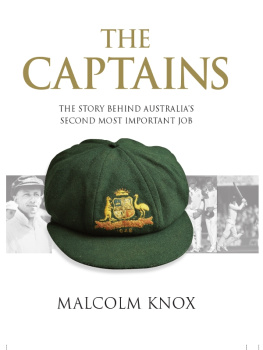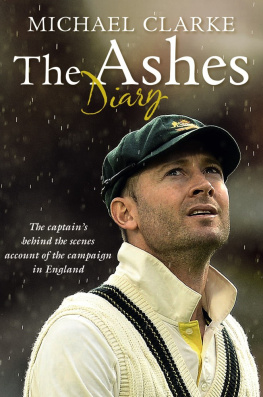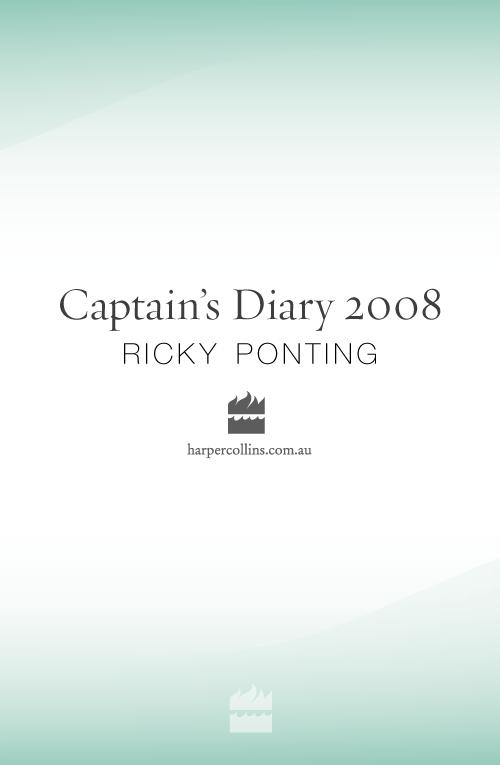Its amazing how, no matter how much you might
like to think youve seen it all in international
cricket, something new and totally unexpected
happens every year. However, there are some
constants, and for me the most important is the
total support I always receive from my wife
Rianna. Now, we have the beautiful Emmy to keep
us company. Whatever stresses might consume my
cricket life, my family life is always fantastic and
for that I am extremely grateful.
Table of Contents
As he has done in past years, Ricky Ponting kept notes on all the major events that occurred during the 2007-08 season. Afterwards, the two of us went through that material, and also studied numerous newspaper and internet reports, to record in a diary formatnot a day-by-day account; rather, a few days at a timehis take on what will be remembered as one of the most tumultuous 12 months ever experienced by the Australian cricket team. In addition, following his review of the Commonwealth Bank Series, Ricky provides his take on the extraordinary career of Adam Gilchrist, and then looks back on his time playing with the Kolkata Knight Riders in the first edition of the Indian Premier League.
Given the level of controversy relating to the Australia v India Test series that took place between December 26, 2007, and January 28, 2008, Ricky has also taken the opportunity to describe, from his perspective, the events that shaped that tumultuous time in cricket. This analysis, which introduces Captains Diary 2008, is followed by a response from Cricket Australias Chief Executive Officer James Sutherland, which has been written specifically for this book.
Ricky and I appreciate James contributing to the book in this way, and we are also grateful for the help provided by others at Cricket Australia, most notably Peter Young and Philip Pope. We must also acknowledge the strong support we received from Rickys manager James Henderson and the entire team at DSEG, and from everyone at HarperCollins, especially Mel Cain, Patrick Mangan, Matt Stanton and the legendary Graeme Jones. Thanks, too, to Alexia Pettenon, Stella Tarakson and Steve Keipert for the help they provided in getting the words in the right order.
In the book, many of the Australian players are referred to by their nicknames. Some of these are self-explanatory (Gilly, Symmo, Mitch, Hadds, Jaquesy, Huss, Kato, Hoggy, et al), but a few probably need clarifying: Haydos is Matthew Hayden; Pup is Michael Clarke; Sarf is Stuart Clark; Bing is Brett Lee; Vin is coach Tim Nielsen. The statistics, scores and averages that appear through the pages and at the end of the book were derived from a variety of sources, including three excellent websitesCricinfo.com, Howstat.com: the cricket statisticians and cricketarchive.com.
With the exception of the photograph of Ricky, Rianna and Emmy Ponting (which was kindly provided by Newspix), all the photographs that appear in Captains Diary 2008 come from Getty Images. We appreciate the help provided by the good people at Getty, especially Philippa Hutson and their outstanding photographers who follow the Australian cricket team around the world.
Geoff Armstrong
August 2008
My overall emotion and feeling at the end of the game was as good a feeling as Ive ever had on a cricket field.
Ricky Ponting, after the second Test v India,
January 6, 2008
HES DONE IT AGAIN!
I wouldnt say those words sent a chill up my spine, or anything that sinister, but they certainly stopped me in my tracks.
Hes done it again! shouted Michael Clarke in my direction during the third days play of the Australia-India New Years Test in Sydney. He just called Symmo a monkey again!
The he was Harbhajan Singh, Indias No. 1 spinner, a man known throughout the cricket world for his instantly recognisable turban, an excellent bowling rsum in international cricket that dates back to 1998, and also for the fact that he is feisty sort of character. He and I had enjoyed some battles over the previous 10 years, going back to Australias tour of India in 98. No bowler had dismissed me more often in Test cricket, but that record was far from my mind when this incident occurred. The word that jumped out at me, however, when Pup (as Michael Clarke is known) called out to me was again. Harbhajan had form.
Back on the previous October 17, in Mumbai, immediately after wed finished the final one-day international of a seven-match series, our player of the series, Andrew Symonds, a man of part Afro-Caribbean descent, informed us that when we had been fielding Harbhajan had called him a monkey. If he had, it was a racist jibe, one that echoed some of the rubbish that had been coming from a section of the big crowds in the grandstands. We debated among ourselves whether we should do anything about it. Eventually, Symmo stood up and said, Ill fix it. He walked out of our dressing room, knocked on the Indian teams door, asked to see Harbhajan, confronted him and said flatly, Dont do it again. When Symmo returned to our room, he told us that after he explained how much the insult had affected him. While Harbhajan had not admitted that he said it, he did acknowledge that it was unacceptable, had apologised for any offence, and assured Symmo thered be no repeat. The two men shook hands. On that basis, we decided that the right thing to do was exactly what our critics told us we should have done in Sydney: we gave him another chance. We just let it go.
THE INCIDENT IN SYDNEY started with Symmo, at mid-off, and Harbhajan, at the non-strikers end during an important stand with Sachin Tendulkar, exchanging a few words between deliveries. We had scored 463 in our first innings, of which Symmo had scored 162 not out, but now, just after tea on day three, Harbhajan and Tendulkar had brought the visitors just about level with our total, when 20 overs earlier it had seemed wed be enjoying a significant first-innings lead. Then Harbhajan got on strike, and he slashed a Brett Lee riser for four over the slip cordon and then squeezed a yorker out behind square for a single. As he ran through for the one, he tapped Binger on the behind (we werent quite sure why), and that got Symmos back up even more. At the end of the over, as had occurred in Mumbai, Harbhajan marched towards Symmo, who was walking from mid-off to mid-off, so they were face to face, and then he said something. I didnt see that confrontation, as I was more concerned with talking to our left-arm quick, Mitchell Johnson, who was about to bowl the next over. That was when I heard Pups shout
Hes done it again! He just called Symmo a monkey again!
The clarity I felt at this moment was a result, I believe, of the fact that from my perspective it was such a straight repeat of what had occurred in Mumbai, combined with the precise instructions concerning on-field racial abuse that Id been given as captain by International Cricket Council (ICC) match referees before Test and one-day series over the previous two years. Ive got to act on it. I talked to Symmo, to get his version as to what had happened. Then I went over and told umpire Mark Benson what we believed had just gone on, and I asked him to do something about it. Benson walked over to Harbhajan and Tendulkar, put his hand over his mouth so he couldnt be lip-read, and, I presume, asked Harbhajan if he had said what we were accusing him of saying. Harbhajan said he hadnt. Benson went back to his position, while I made a point, as I walked past the two batsmen on my way to the slip cordon, to say to the Indian spinner, I hope you havent said that again.











